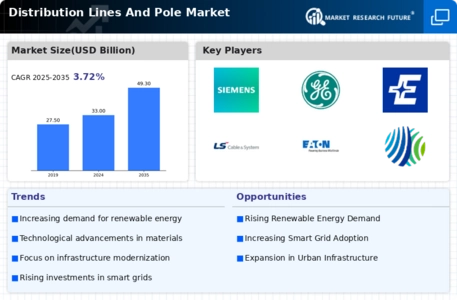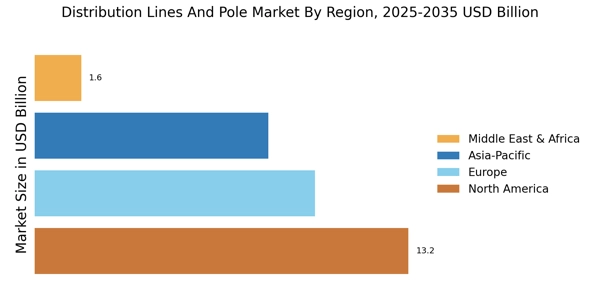Urbanization Trends
Urbanization is a significant driver of growth in the Distribution Lines And Pole Market. As populations migrate to urban areas, the demand for electricity increases, necessitating the expansion of distribution networks. This trend is particularly evident in developing regions, where rapid urban growth is outpacing existing infrastructure capabilities. The need for reliable electricity supply in densely populated areas is prompting investments in new distribution lines and poles. Moreover, urban planning initiatives often prioritize sustainable energy solutions, further driving the demand for modern distribution infrastructure. As cities evolve, the Distribution Lines And Pole Market is likely to experience sustained growth to meet these emerging needs.
Regulatory Frameworks
Regulatory influences play a crucial role in shaping the Distribution Lines And Pole Market. Governments worldwide are implementing policies aimed at enhancing energy efficiency and promoting the use of renewable energy sources. These regulations often require utilities to upgrade their distribution infrastructure to comply with new standards. For instance, mandates for reducing transmission losses and improving grid reliability are pushing utilities to invest in modern distribution lines and poles. Additionally, incentives for renewable energy integration are further driving the need for infrastructure improvements. As regulatory frameworks evolve, they are expected to create both challenges and opportunities for the Distribution Lines And Pole Market, influencing investment strategies and operational practices.
Technological Innovations
Technological advancements are reshaping the Distribution Lines And Pole Market in various ways. Innovations such as advanced materials for poles, smart sensors, and automated monitoring systems are enhancing the performance and longevity of distribution lines. These technologies not only improve operational efficiency but also reduce maintenance costs, which is crucial for utility companies. The adoption of smart grid technologies is particularly noteworthy, as it allows for real-time monitoring and management of electricity distribution. This trend is expected to drive investments in the Distribution Lines And Pole Market, as utilities seek to modernize their infrastructure to meet the demands of a changing energy landscape.
Infrastructure Development
The ongoing expansion of infrastructure is a pivotal driver for the Distribution Lines And Pole Market. As urbanization accelerates, the demand for reliable electricity distribution systems increases. Governments and private entities are investing heavily in upgrading existing infrastructure and constructing new distribution networks. For instance, in many regions, the investment in electricity distribution infrastructure is projected to reach billions of dollars over the next decade. This trend is likely to enhance the efficiency and reliability of power delivery, thereby stimulating growth in the Distribution Lines And Pole Market. Furthermore, the integration of smart grid technologies is expected to play a crucial role in modernizing distribution lines, making them more resilient and capable of handling increased loads.
Renewable Energy Integration
The shift towards renewable energy sources is significantly influencing the Distribution Lines And Pole Market. As countries commit to reducing carbon emissions, the integration of solar, wind, and other renewable energy sources into the grid is becoming increasingly prevalent. This transition necessitates the development of new distribution lines and poles to accommodate decentralized energy generation. According to recent estimates, the share of renewables in the energy mix is expected to rise substantially, leading to a corresponding increase in demand for distribution infrastructure. Consequently, the Distribution Lines And Pole Market is poised for growth as utilities and energy providers invest in modernizing their distribution networks to support this transition.


















Leave a Comment